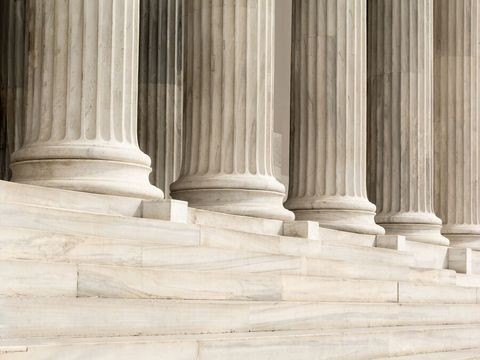House Settlement Approved: How to Prepare for Implementation by July 1, 2025
What You Need to Know
Key takeaway #1
New Enforcement Agency: The College Sports Commission (CSC) is charged with oversight and enforcement of revenue-sharing and Name, Image, and Likeness (NIL) deals.
Key takeaway #2
Revenue Sharing: Under the new revenue-sharing framework, Division I schools can directly pay athletes, subject to an annual cap of $20.5 million per school.
Key takeaway #3
Roster Limits: In place of scholarship limits, schools must now abide by various roster limits for each sport.
Key takeaway #4
Opt-In: Schools have the option to opt-in or opt-out of the settlement, including the new revenue-sharing framework.
Client Alert | 7 min read | 06.18.25
On June 6, 2025, Judge Claudia Wilken issued final judgment in the In re College Athlete NIL Litigation, No. 4:20-cv-03919 (N.D. Cal.), approving the Fourth Amended Settlement Agreement commonly known as the “House Settlement.” The House Settlement drastically changes how Division I athletes are compensated, and will likely have far-reaching implications for higher education NCAA-member institutions and student-athletes.
Background
As detailed in Crowell’s primer on the House settlement (“Settlement”) earlier this year, the Settlement is the product of a consolidated set of three antitrust actions brought by current and former Division I athletes: House v. NCAA: Hubbard v. NCAA; and Carter v. NCAA.
Plaintiffs in House, Hubbard, and Carter asserted that the NCAA and its conferences violated antitrust laws by restricting Plaintiffs' and Class Members’ rights to license and sell the rights to their names, images, and/or likenesses (NIL). Plaintiffs also argued that the NCAA’s scholarship limits and prohibitions on revenue-sharing were collusive restraints in violation of the Sherman Act. A Final Approval Hearing was held on April 7, 2025, after which the Court issued an order expressing concerns that some settlement class members could be harmed by immediate implementation of certain provisions regarding roster limits in the proposed settlement.
The parties filed a proposed Fourth Amended Stipulation and Settlement on May 7, 2025, containing modifications to address the concerns raised by the Court. On June 6, 2025, Judge Claudia Wilken granted Plaintiffs’ motion for final approval of that amended settlement proposal, which includes $2.576 billion in damages for members of the settlement classes as well as a number of significant changes to NCAA rules that are predicted to create approximately $1.6 billion in new compensation and benefits for Division I athletes per year.
Key Provisions of the House Settlement
Damages. Defendants agreed to pay $2.576 billion to members of the damages class over ten years following the Effective Date of the Settlement.
NIL Settlement Fund. A $1.976 billion fund will be distributed to members of the damages class with NIL-related injuries, including those related to broadcasting rights, videogames, and other third-party compensation for NIL.
Additional Compensation Fund. The Settlement also requires the creation of a $600 million “Additional Compensation Claims Settlement Fund” that will be distributed to members of the Settlement Class with pay-for-play claims, a.k.a. claims by athletes who were prohibited from receiving payment for athletic services under the NCAA’s previous rules. Currently, the Settlement allocates 95% of this fund to the “Power Five Football and Basketball Portion” to be distributed in a 75/15/5% ratio to athletes in football, and men’s and women’s basketball. The remaining 5% of the fund is allocated to class members of other sports who received a partial or full Grant-in-Aid scholarship. These allocations have already been appealed to the Ninth Circuit by eight female athletes alleging gender discrimination under Title IX, and are likely to generate further disputes.
Direct benefits and compensation from NCAA-member schools. The NCAA may now permit member-schools to provide direct benefits and compensation to Division I athletes up to 22% of the Power Five school’s average athletic revenues each year. This Pool cap will be calculated annually as set forth in the Settlement, and is estimated to start at more than $20 million per school for the 2025-26 school year. This cap is expected to grow to $32.9 million per school by 2034-35.
Elimination of scholarship limits. Subject to certain limits, the Settlement requires the NCAA to eliminate scholarship limits. The elimination of these limits is expected to result in over 115,000 additional scholarships being made available to Division I athletes annually.
Narrow NIL payment prohibitions. The NCAA is allowed to continue prohibiting NIL payments to student-athletes, but must narrow those prohibitions such that they only pertain to a limited set of third-parties labeled as Associated Entities or Individuals. An “Associated Entity” is defined as “one that is closely affiliated with an NCAA member school for the purpose of promoting the school’s athletics program or its student-athletes,” and an “Associated Individual” is defined as “an individual who is a member of an Associated Entity or who has contributed more than $50,000 over their lifetime to a particular NCAA member school, or an Associated Entity, to promote their athletes.” Payments from these entities and individuals may be prohibited if they are not for a “valid business purpose.”
Roster limits. The NCAA is now permitted to adopt roster limits for Division I sports, with the caveat that any class members whose spots would be taken away because of immediate implementation of the Settlement will be exempt from those roster limits for the duration of their college athletic careers. Within 30 days of approval of the Settlement, the parties must identify affected athletes for these purposes.
New enforcement agency. The College Sports Commission (CSC) will oversee revenue-sharing schemes and will ensure that NIL deals comply with the new rules.
What’s Next?
The Settlement’s injunctive relief provisions officially went into effect when final judgment was issued on June 6, 2025, regardless of whether there is an appeal. However, the official implementation date of the Settlement is July 1, 2025, which is when schools may begin to distribute paychecks to student athletes.
Now that the Settlement has been approved, the NCAA and the Power Four conferences (ACC, Big Ten, Big 12, and SEC) will be paying the majority of the $2.8 billion in back pay due to student athletes over the next ten years. The NCAA is responsible for $1.1 billion of those damages, while the Power Four will be paying around $664 million. The other $990 million will be paid by the other 27 Division I conferences.
The NCAA’s Settlement Implementation Committee, announced in March, will be tasked with drafting new rules and modifying prior rules to comply with the settlement in preparation for July 1. Deloitte will be operating a clearinghouse for NIL deals worth over $600 with “associated entities or individuals,” vetting such agreements to ensure that they are “fair market value.” On behalf of the CSC, Deloitte will maintain a technology platform called NIL Go, in which student-athletes will be required to report their NIL deals to confirm they compliant with the rules. According to an FAQ on the CSC website, deals will be evaluated on:
- Payor association – The relationship between the payor and the student-athlete’s school.
- Valid business purpose – Whether the payor is seeking the use of the student-athlete’s NIL for a valid business purpose, meaning to sell a good or service to the public for profit.
- Range of compensation – Whether the compensation paid to the student-athlete is commensurate with compensation paid to similarly situated individuals.
It remains to be seen how the CSC will ensure that all NIL deals required to be reported will be submitted to Deloitte. The definition of “associated entity” and “associated individual” are likely to become the subject of further dispute, as is the specific content sufficient for a report.
Colleges and universities should review the Settlement closely now that it has been approved. While some provisions leave little room for interpretation, like the removal of limits on scholarships, others allow individual schools more flexibility for implementation. For example, the Settlement does not provide a legal framework for how to distribute the allowed $20.5 million annual cap on direct benefits and compensation amongst different sports. The identification of “Designated Student-Athletes,” student-athletes exempt from roster limitations, may also become a point of contention.
In addition, not all Division I schools are required to adopt the new framework. The named defendants must comply with the settlement and many others are expected to opt-in, but others are free to opt-out and continue to compensate athletes via scholarships and other attendance cost-related benefits.
Now that the Settlement is approved, affected colleges and universities should reach out to legal counsel to ensure that they are in compliance with the terms of the Settlement and that they are taking advantage of new opportunities for athletic funding and student athlete recruitment. Please contact one of the attorneys below or your regular Crowell contact to learn more.
Contacts
Insights
Client Alert | 5 min read | 12.12.25
Eleventh Circuit Hears Argument on False Claims Act Qui Tam Constitutionality
On the morning of December 12, 2025, the Eleventh Circuit heard argument in United States ex rel. Zafirov v. Florida Medical Associates, LLC, et al., No. 24-13581 (11th Cir. 2025). This case concerns the constitutionality of the False Claims Act (FCA) qui tam provisions and a groundbreaking September 2024 opinion in which the United States District Court for the Middle District of Florida held that the FCA’s qui tam provisions were unconstitutional under Article II. See United States ex rel. Zafirov v. Fla. Med. Assocs., LLC, 751 F. Supp. 3d 1293 (M.D. Fla. 2024). That decision, penned by District Judge Kathryn Kimball Mizelle, was the first success story for a legal theory that has been gaining steam ever since Justices Thomas, Barrett, and Kavanaugh indicated they would be willing to consider arguments about the constitutionality of the qui tam provisions in U.S. ex rel. Polansky v. Exec. Health Res., 599 U.S. 419 (2023). In her opinion, Judge Mizelle held (1) qui tam relators are officers of the U.S. who must be appointed under the Appointments Clause; and (2) historical practice treating qui tam and similar relators as less than “officers” for constitutional purposes was not enough to save the qui tam provisions from the fundamental Article II infirmity the court identified. That ruling was appealed and, after full briefing, including by the government and a bevy of amici, the litigants stepped up to the plate this morning for oral argument.
Client Alert | 8 min read | 12.11.25
Director Squires Revamps the Workings of the U.S. Patent Office
Client Alert | 8 min read | 12.10.25
Creativity You Can Use: CJEU Clarifies Copyright for Applied Art
Client Alert | 4 min read | 12.10.25
Federal Court Strikes Down Interior Order Suspending Wind Energy Development






